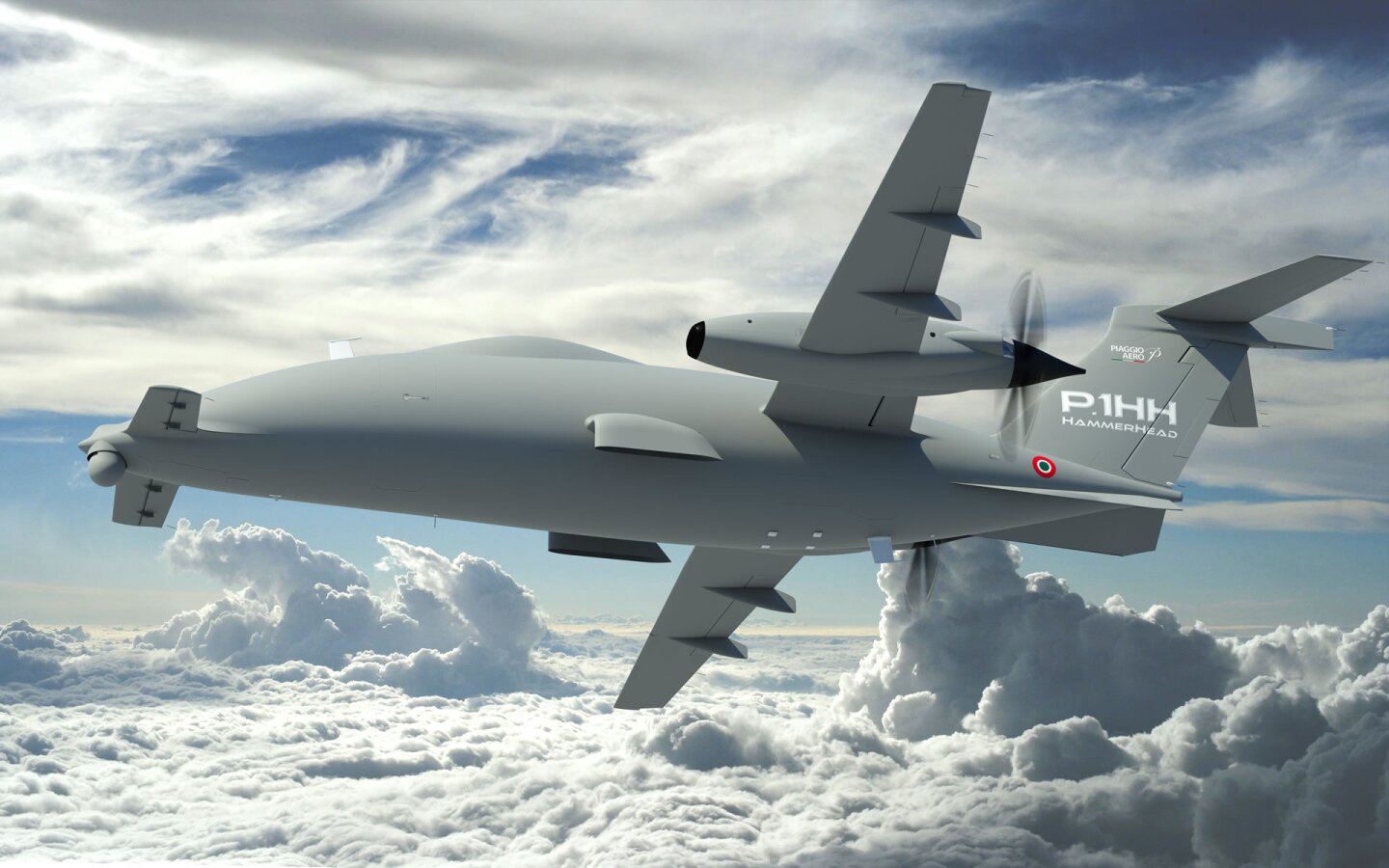There was an unusual shape in the skies over Italy last week as the Piaggio Aero Company and Selex ES successfully completed the first flight of the aptly-named Hammerhead UAV on Thursday, November 14, near the Trapini Air Force Base. The aircraft was remotely controlled from the ground, with no crew on board, while two chase planes kept the UAV in sight during the flight.
The Hammerhead is a derivative of the Piaggio Avanti II turboprop executive transport, a fast and high flying aircraft that was designed and manufactured in Italy. The Avanti II has a patented “three lifting surfaces” design, with a small canard wing in the front of the aircraft, a thin, high aspect ratio wing, and an elevator on a tall T-shaped tail. Piaggio claims that this configuration is highly efficient and lets this aircraft get excellent gas mileage.
Also unusual are the pusher engines – the Pratt and Whitney PT6A-66B 850 shaft horsepower engines are mounted backwards, with the propellers in the back of the aircraft. The company claims this arrangement is more efficient and results in a smoother ride as it allows the wing to fly in clean air.

This is not the first time the plane has been airborne, as on the 8th of August it made a short flight, lifting off and then immediately setting down again on the same runway.The flight on November 14th was more ambitious, as the aircraft climbed away from the airport and cruised over the Mediterranean Sea for about 12 minutes before returning to base and landing safely. Cruise speed for the test was 170 kts (195 mph/315 km/h), and the landing gear and flaps remained down for the entire flight, which is a normal precaution on first flights.
The main purpose of the November 14 flight was to check out the Remote Vehicle Control and Management System (VCMS) and the Ground Control Station. The VCMS was provided by Selex ES, which is partnering with Piaggio in the development of the UAV system. The Mission Management system is based on the existing Selex ES skylSTAR software, which is designed to support patrol and surveillance missions. It has data fusion, data management, and video exploitation features that service missions from border control, wide area surveillance, environmental data collection, and disaster control.
"The first flight achievement demonstrates the huge progress made by Piaggio Aero, together with Selex ES and the support of the Italian Air Force, in the development of this new generation of Unmanned Aerial Systems. We are proud to have been able to reach this result only two years after the launch of the program, and we look forward to completing this ambitious project that brings together the efforts of leading players in the aerospace and defense domain and will allow Piaggio Aero to gain a primary position in the international surveillance and security industry with the P.1HH HammerHead to enter into service in 2015." said Alberto Galassi, CEO of Piaggio Aero.
Piaggio: Not just Vespas
Piaggio may be a familiar name, but not for aircraft. The company was originally founded in 1884, working first with locomotives. It began designing aircraft engines in 1915, and was a major force in aviation in the 20’s and 30’s. After the war, the son of the original designer invested in making scooters, and the famous Piaggio Vespa (or Wasp in Italian) was born. The design of the scooter was influenced by the aeronautical engineers on the aircraft side of the business. There are millions of Vespa’s worldwide, and it has become a cultural icon.Today, Piaggio Aero is a completely separate business. Work on the Avanti or P180 began in 1979, with the aircraft taking 10 years to develop into a production aircraft. It was reborn as the Avanti II with the involvement of one of the sons of Enzo Ferrari, and today the two companies have a close relationship.
The Avanti II is a high speed turboprop that can reach an altitude of 41,000 feet and cruise at Mach 0.7, which is on par with many small jets. The fuselage is designed as one continuous aerodynamic curve, which creates a cabin that is largest in the middle. The Avanti is not just a transport aircraft, but is also available configured as an air ambulance, or as a manned “special missions” aircraft with surveillance equipment.

The UAV version, the Hammerhead, is slightly different from the passenger plane. The wings are a bit longer, and the airframe has been stiffened. To accommodate transportation, the wings can be removed easily. Flight endurance has been increased to 16 flight hours. While this endurance is impressive for a manned aircraft, it is not exceptional for unmanned aircraft of this size, which commonly fly for 24 hours or more.
The Hammerhead can carry a variety of payloads, and seems to be mostly destined for maritime patrol, not surprising for a country with an enormous coastline like Italy. The most visible payload is the EO/IR (Electro-Optic, Infrared) camera ball on the front, which is made by the US company FLIR. The aircraft also carries a marine radar, a SeaSpray 7300, and is equipped with AIS (Automatic Identification System), a transponder system that identifies ships at sea.
A video of the first flight of the HammerHead UAV can be viewed here.
Sources: Piaggio, Aviation Today










